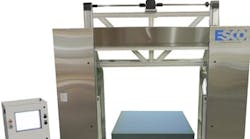As energy costs drive insulation sales, automated equipment gives fabricators the ability to deliver high-performance industrial pipe coverings more efficiently and profitably “on demand.”
Increasing energy costs have brought about a dramatically increased demand for commercial and industrial insulation for all kinds of thermal and moisture resistance applications.
Among the more prevalent insulation materials are the rigid polyurethane, polyiso (polyisocyanurate) and Foamglas® types of materials that are used for jacketing pipes used in countless refrigeration, ovens, storage, processing and transportation applications.
Because some of these industries require miles of pipe insulation at a single installation, or have a need for specific materials, sizes and shapes, the fabrication of foam pipe insulation has evolved into an automated production business that can satisfy customers on demand.
The solution to on-demand foam fabrication for pipe insulation as well as many other uses has been advancements in the computer numerical control (CNC)-automated foam cutting machines that enable fabricators to quickly and efficiently trim and shape a wide variety of foam-type materials, including the rigid PU polyisocyanurate (PIR), Foamglas, mineral wool and calcium silicate.
The benefits of this advanced, automated production equipment are quite compelling at all levels, including the fabricator, distributor/specialist and end-user.
“It saves money across the board,” says Tommy Jernigan, general manager at Performance Insulation (Nashville, TN), a commercial-industrial pipe insulation specialist for over 50 years. “The automated foam cutting equipment we are now using probably cuts our waste by 30%, and labor even more,” Jernigan explains. “In the past we had two or three people operating the sawing equipment. But today we have only one operator, so that’s a savings of over 66%” Jernigan says that in early 2010 his firm purchased a ProfileMatic, a CNC-based, horizontal foam saw manufactured by Edge-Sweets (ESCO), a Grand Rapids, MI-based developer and manufacturer of PU fabrication and dispensing equipment.
The ProfileMatic gives Performance Insulation as much latitude as necessary to meet the firm’s contractor and direct customers with just-in-time efficiencies or orders that are often custom specified by customer engineers or materials consultants.
“Most of the work done on this equipment is on demand,” Jernigan says. “The customer (e.g. refrigeration or petrochemical plant) places an order and we process it at that time. This is not only more efficient, but also saves on warehousing costs.”
Workable Hardware/Software Interface
Among the important considerations in choosing automated insulation fabrication systems are equipment flexibility and user friendliness of the hardware, software and HMI (computer) interface. For instance, it may add considerable efficiency and payback if the equipment can optimize foam usage by cutting in “nested” configurations. Nesting is achieved through system software that enables you to get multiple items out of a foam block or bun that might otherwise produce unnecessary waste.
Another powerful feature of ESCO’s nesting software is the ability to select common ASTM pipe sizes directly from the HMI interface. This functionality eliminates the need to draw each pipe size and joint type. Users select the desired pipe size from the predefined ASTM chart or custom data supplied by the customer, enter the quantity desired, and click “nest.”
Jernigan mentions that his firm often uses the integral ASTM chart, which he says adds to his fabrication productivity. Equipment flexibility can also require advanced dual vertical and horizontal cutting heads. This capability enables fabricators to produce even complex shapes in 3D, cutting multiple shapes at a time. A user-friendly HMI interface is another fabrication system feature that impresses Jernigan with his system.
“The equipment is very user friendly, including the software. Many years ago we looked at some profile machines and they required that you be CAD proficient to run the equipment. With the software that is available now, it is very user friendly. If you can use a PC, you can use the fabrication software.” Jernigan adds that a combination of hardware and software capabilities enables his ProfileMatic to handle cutting of popular Foamglas cellular-glass material. Whenever possible, fabricators like Jernigan will fuse Foamglas blocks together using grout such as Hydrocal. “With the Foamglas material you can join leftover pieces together to minimize waste, or you can cement block together to create a larger foam block,” Jernigan explains. “But you have to slow down your blade when you hit that grout rib, which is like concrete. The ProfileMatic has software (Advanced Profile Management) that allows you to do that automatically. It can also compensate for the fact that in many cases your grout joint may not be exactly in the same spot with every block. So, you want to make sure that you give the software a range where it should slow down and cut through the grout.” It can also be very productive to establish a close relationship with fabrication equipment suppliers before you acquire or upgrade equipment. For instance, while ESCO makes a full range of automated fabrication systems, the firm considers every application as virtually a one-off. Therefore, its engineers collaborate directly with customers to ensure that their present and future needs are realized in the equipment they select.
For example, Performance Insulation was running an older Windows version when the company first installed the ProfileMatic system. “A few months later we got the latest Windows operating system, and so we needed some profile cutting software modification,” says Jernigan. “The people at ESCO accessed our computer online and were able to upgrade it so that it worked perfectly after that.”








